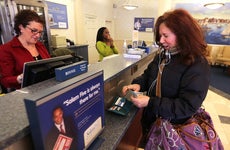How to open a bank account online

The Bankrate promise
At Bankrate we strive to help you make smarter financial decisions. While we adhere to strict , this post may contain references to products from our partners. Here's an explanation for .
As the world becomes more digitally savvy, many consumers are increasingly switching over to online banking. Having an account that’s accessible whenever and wherever internet access is available makes it easier to do such tasks as check your balance, make person-to-person transfers and pay bills. Plus, banks that are solely online usually offer higher rates on their products.
Banks have made opening an account online a relatively convenient and straightforward process. To open a bank account online, here is what you’ll need and what to expect.
Key takeaways
- It is important to research and compare different online bank accounts before choosing one.
- The application process typically requires personal information and documentation, such as a Social Security number and proof of address.
- Many online banks offer no-fee and high-yield account options, making it financially beneficial for consumers to open an account online.
Step 1: Choose the type of account you want
First, consider what you’ll be using your online bank account for. If you’re building an emergency fund, you’ll want to look into savings accounts. If you’re looking for an account you can easily withdraw money from, you’ll want to open a checking account with sufficient ATM access.
These are some types of accounts typically offered online:
Some details to consider when choosing your account include annual percentage yields, fees, transaction limits and digital tools. Many banks offer similar products that will vary when it comes to these details, which are usually found in the accounts’ terms and disclosures. Checking accounts, for example, frequently charge monthly fees, but there are plenty of online checking products that don’t charge them. Bankrate has put together a list of no-fee checking accounts that you can compare.
It’s worth looking into digital tools that come with the account to see what banking shortcuts they may offer. One popular tool is online bill pay, which is handy if you intend to use your online account to pay bills. Additionally, some online and mobile bank accounts have a feature that allows customers to lock a debit card instantly if you lose it or notice suspicious activity on it.
You’ll also want to make sure that the bank is insured by the Federal Deposit Insurance Corp., which guarantees you won’t lose any funds held in the bank — should it fail — up to specified limits.
Step 2: Gather your personal documentation
An online bank account application will ask for personal information to verify your identity and secure your account.
The application process can be long, but to help shorten it, prepare as much of your information and documentation ahead of time as possible. Some of the information banks often ask for on applications include:
- Personal information, including address and birth date
- Social Security number
- A driver’s license or other government-issued ID
- A bill with your name and address on it
- Other bank account routing and account numbers to fund the new account
Step 3: Submit your online application
On the bank’s website, look for a button or link that says “Open an account” or something similar. When you click this, it should initiate the application process, where you’ll be asked to provide your personal information and documents.
When submitting documentation online during the application process, you may be asked to upload each document separately. Occasionally, you may need to fax or email documents to the institution to prove your identity.
Depending on the bank and type of account, you may also be asked to choose specific features, such as overdraft protection, debit card options or paperless statements.
Step 4: Fund your new account
There are several ways to make an initial deposit into an online bank account. A common way to fund the account is by linking an existing bank account and transferring money over. In many cases, you’ll also be able to digitally deposit a check by uploading pictures of it or even fund your account through PayPal.
If your bank also has brick-and-mortar locations, you may be able to visit a branch to deposit cash into the account.
When funding your new account, make sure you meet the minimum deposit requirement. Many banks will note that they require a minimum opening deposit either on the product’s homepage or in its disclosures. Additionally, the account may have a minimum balance that you’re required to sustain to avoid fees.
Can I open a bank account online for free?
Many online banks have free bank account options, which don’t have an initial deposit requirement or monthly fee. Those options might include basic savings accounts and free checking accounts.
In some cases, a free account might pay less interest (or none), but that’s not always the case. For example, Ally Bank‘s checking account is interest-bearing and has no monthly fee or minimum deposit requirement.
In addition, some banks may have monthly fees for certain accounts but provide opportunities to waive these fees. For instance, a bank might offer a fee waiver if you set up direct deposit, maintain a certain average monthly balance or meet other qualifying criteria.
Bottom line
Though it may look a bit different than opening an account at a branch, setting up an online bank account can make banking much more convenient and have financial benefits, too. You’ll have access to much higher APYs, and often, an online bank account may have lower or no monthly fees.
If you prepare ahead of time by researching different bank accounts and gathering documentation, the process of opening an account can be straightforward. You may not be able to receive in-person customer service, but banks want to ensure that your application is successful, so they will have some type of customer service available. In most cases, you can talk to a customer service representative over the phone or through an online chat feature.
Related Articles

Looking to open a business checking account? Here’s 7 things you may need first


